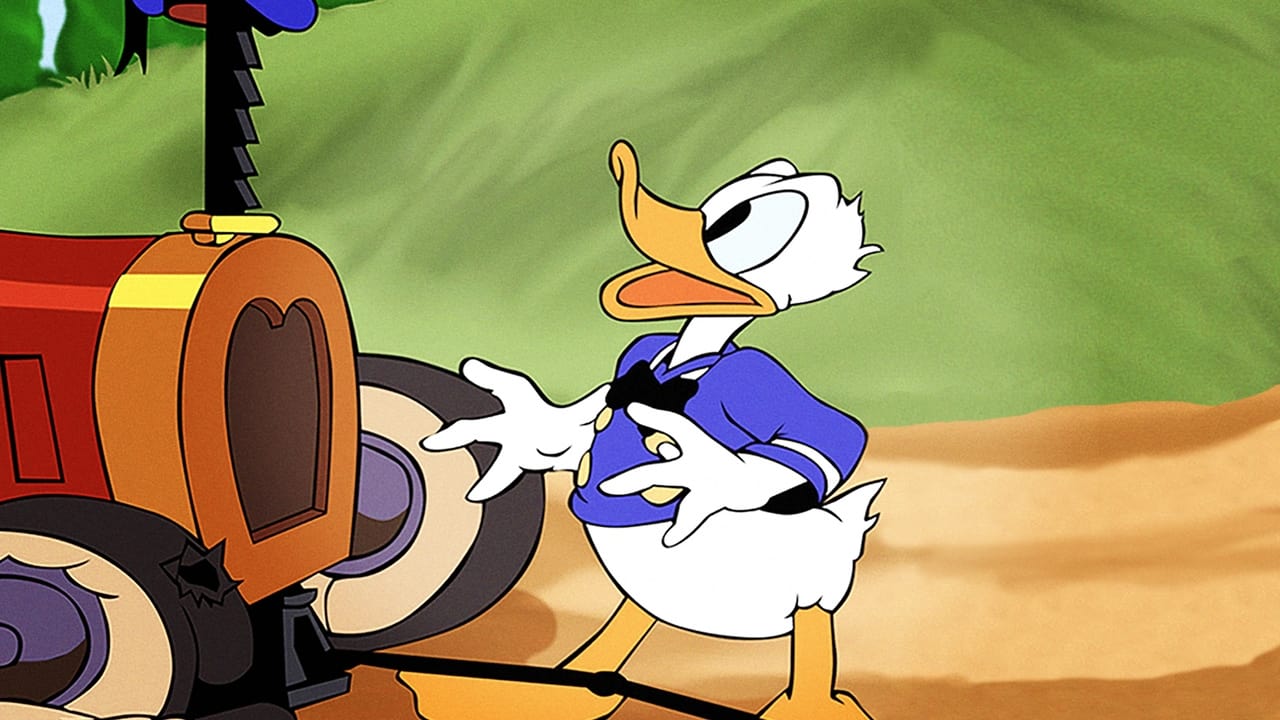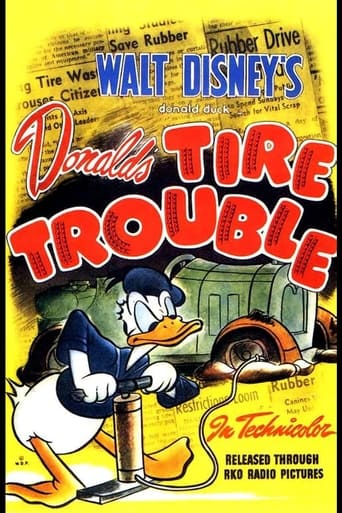




Truly Dreadful Film
one of my absolute favorites!
Good start, but then it gets ruined
Great example of an old-fashioned, pure-at-heart escapist event movie that doesn't pretend to be anything that it's not and has boat loads of fun being its own ludicrous self.
View MoreDonald's Tire Trouble (1943) *** (out of 4)Donald is out in the country speeding along in his car when suddenly he gets a flat tire. What should be an easy fix turns into a nightmare.DONALD'S TIRE TROUBLE isn't what I'd consider a Disney classic but if you're a fan of the little duck then you should have a good time with it. Basically we get a lot of action as poor Donald keeps trying to get the tire fixed only to run into another problem. The short really didn't make me laugh but the animation itself was creative enough to where it kept me entertained throughout the running time. The highlight certainly happens towards the end when Donald has reached his limits and a breakdown follows.
View MoreI have always loved Disney and Donald Duck as I have said quite a number of times. Donald's Tire Trouble is another entertaining cartoon, while very funny it also gently pokes fun at the rubber shortage caused by rationing during World War II. The animation is pristine, bursting with colour and beauty. True, the blurring effect with the car is dated but compared to the small amount it is featured it is not so much an issue for me. The music is typically energetic and Donald with impeccable voice work as ever from Clarence Nash is temperamental and likable.In conclusion, terrific, entertaining cartoon. 10/10 Bethany Cox
View MoreA Walt Disney DONALD DUCK Cartoon.DONALD'S TIRE TROUBLE starts when the speed demon gets a flat on a lonely mountain road.There's lots of fun in this little film in watching the Duck deal with inanimate objects which seem bent on destroying him. Younger viewers may not understand Donald's exasperation with retreads, or the significance of rubber patches, but this cartoon was produced during wartime and poked gentle fun at the rubber shortage caused by rationing. Clarence "Ducky" Nash provides Donald with his unique voice.Walt Disney (1901-1966) was always intrigued by drawings. As a lad in Marceline, Missouri, he sketched farm animals on scraps of paper; later, as an ambulance driver in France during the First World War, he drew figures on the sides of his vehicle. Back in Kansas City, along with artist Ub Iwerks, Walt developed a primitive animation studio that provided animated commercials and tiny cartoons for the local movie theaters. Always the innovator, his ALICE IN CARTOONLAND series broke ground in placing a live figure in a cartoon universe. Business reversals sent Disney & Iwerks to Hollywood in 1923, where Walt's older brother Roy became his lifelong business manager & counselor. When a mildly successful series with Oswald The Lucky Rabbit was snatched away by the distributor, the character of Mickey Mouse sprung into Walt's imagination, ensuring Disney's immortality. The happy arrival of sound technology made Mickey's screen debut, STEAMBOAT WILLIE (1928), a tremendous audience success with its use of synchronized music. The SILLY SYMPHONIES soon appeared, and Walt's growing crew of marvelously talented animators were quickly conquering new territory with full color, illusions of depth and radical advancements in personality development, an arena in which Walt's genius was unbeatable. Mickey's feisty, naughty behavior had captured millions of fans, but he was soon to be joined by other animated companions: temperamental Donald Duck, intellectually-challenged Goofy and energetic Pluto. All this was in preparation for Walt's grandest dream - feature length animated films. Against a blizzard of doomsayers, Walt persevered and over the next decades delighted children of all ages with the adventures of Snow White, Pinocchio, Dumbo, Bambi & Peter Pan. Walt never forgot that his fortunes were all started by a mouse, or that simplicity of message and lots of hard work will always pay off.
View MoreIn later cartoons Donald would have flesh-and-blood antagonists; here he has nothing to fight, nothing to get mad at, but a punctured tyre. In the 1930s his efforts to repair it would have made up roughly one-third of a larger Mickey/Donald/Goofy enterprise; here, it's the whole show. This is one aspect of Donald's routine reduced to its minimal essence. Never before, and never again, would he be required to do so much with so little. He carries it off magnificently.One of Donald's trademarks is that, although he's always talking, we have to strain to understand a single word he says (I love the way Clarence Nash lapses into comprehensibility and out again as the occasion requires), which makes him an excellent silent comedian, and this is inspired silent comedy. I don't know how many times you'd have to watch it before it ceased altogether to be funny, and even then it would have a kind of beauty.Released early in January 1943 and probably made the previous year, one aspect of the visual style has dated - Disney's effects department cannot, at this stage, make Donald's car blur as it should as it zooms through the countryside. This means that approximately ten seconds of footage are less than perfect. That's about all.
View More